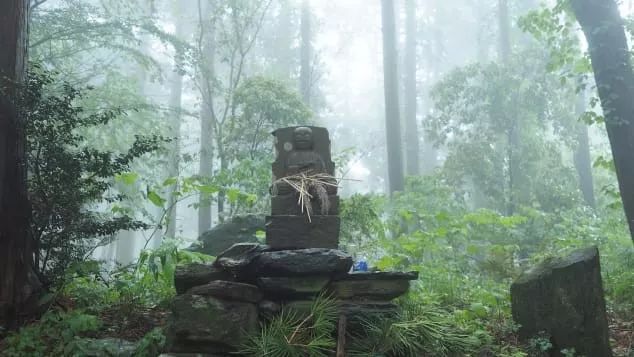玩在日本(2)
Japan experiences every traveler needs to enjoy(2)
一个去寻找安静的国家。
谷歌合成音频
Hanami[1]

Every spring, Japanese celebrate cherry blossoms[2] by gathering and picnicking at parks while admiring the pink blossoms.
每年春天,日本人都会聚集在公园里,一边欣赏粉红色的樱花,一边野餐,庆祝樱花盛开。
For just a few weeks every spring, Japan celebrates an annual ritual[3] known as hanami: stopping to view and appreciate the beautiful spring blossoms.
每年春天,日本都会有几周的时间来庆祝一年一度的樱花会:停下来欣赏美丽的春花。
It’s so popular the Japan Weather Association’s annual sakura[4] (cherry blossom) forecast is broadcast live on TV, while the Japan National Tourism Organization[5] has a regularly updated timetable of cherry blossoms predictions on their website.
日本气象协会一年一度的樱花预测会在电视上直播,而日本国家旅游组织则在其网站上定期更新樱花预测的时间表。
Hiking
徒步旅行

A hike along the Kumano Kodo trail is a Wakayama[6] highlight.
Pongpat Patumsuwon/CNN
沿着久野古道徒步旅行是和歌山的一大亮点。
彭帕Patumsuwon / CNN
Being a mountainous nation, trekking is an extremely popular Japan activity.
作为一个多山的国家,徒步旅行在日本是一项非常受欢迎的活动。
For a spiritual journey, try Kumano Kodo, a multiday pilgrimage across Wakayama prefecture — fueled by great food, cute rural villages and rich culture along the way.
如果你想体验一次心灵之旅,可以尝试一下Kumano Kodo,这是一次跨越和歌山县的多天朝圣之旅,沿途有美味的食物、可爱的乡村和丰富的文化。
More than a thousand years ago, imperial leaders and aristocrats made their way to the main Kumano Kodo shrines through a network of hikes across the island. At the end of the hike we recommend spending the night at a temple in the mountaintop town of Koyasan, the center of Shingon Buddhism.
一千多年前,帝国领袖和贵族们通过遍布全岛的徒步旅行来到了Kumano Kodo的重要神社。徒步旅行结束时,我们建议在山顶小镇高野山(Koyasan)的一座寺庙过夜,那里是新宗佛教的中心。
Here, ancient cedar forests share space with historic pagodas, paved roads, restaurants, schools, cafes and souvenir shops.
在这里,古老的雪松林与历史悠久的宝塔、铺好的道路、餐馆、学校、咖啡馆和纪念品商店和谐共处。
The enchanting Yakushima forest (the setting for Hayao Miyazaki’s epic film Princess Mononoke) on Kyushu island and the Sagano bamboo forest on the outskirts of Kyoto are other family-friendly places to enjoy a quiet walk in Japan.
九州岛上迷人的屋久岛森林(宫崎骏的史诗电影《幽灵公主》的背景)和京都郊外的相野竹林是日本其他适合家庭散步的地方。
TRADITION
传统
Japan excels at striking the right balance between tradition and modernity, leading the way in technological advances while also embracing its past, whether it’s architecture, art, fashion, food or sports.
日本擅长在传统与现代之间取得恰当的平衡,在引领技术进步的同时,也不忘过去,这体现在建筑、艺术、时尚、食品,体育等方方面面。
Here are a few experiences that will give you a taste for Japan’s traditional side.
以下是一些能让你领略日本传统一面的经历。
Stay in a ryokan[7]
住在日式旅馆

Nishimuraya Honkan is a seventh-generation ryokan in Hyogo prefecture[8].
Courtesy Nishimuraya
Nishimuraya Honkan是兵库县的第七代日式旅馆。
Nishimuraya提供
Looking for that classic Japanese inn experience, complete with tatami floors[9], onsen and sliding doors[10]?
寻找经典的日本旅馆的经验,完整的榻榻米地板,温泉和拉门?
Staying in a ryokan, a traditional Japanese guesthouse, is the way to go. Catering to all budgets, they can be found throughout Japan — most commonly in the countryside outside of urban centers.
住在日式客栈(一种日本传统的宾馆)是最好的选择。可以满足各种预算,它们在日本各地都可以找到——最常见的是在城市中心以外的农村地区。
Guests are encouraged to wear yukata[11] (house kimonos) and socks, while traditional Japanese meals are prepared in-house[12].
鼓励客人穿育空(和服)和袜子,而旅馆提供传统的日餐。
Tea ceremonies[13]
茶道
The Japanese tea ceremony, or chado, is a traditional way of preparing and serving matcha[14] (top quality green tea).
日本的茶道(chado)是制作和供应抹茶(顶级绿茶)的传统方式。
To make it, green tea leaves, grown in the shade, are dried and ground into a fine powder[15]. This allows the tea to retain its nutrients[16]. During the ceremony, which focuses on the rituals and mental states achieved in the process, the powder is whisked with hot water in a small bowl until a slight foam appears.
为了制作它,生长在树荫下的绿茶叶子被晒干并磨成细粉末。这使得茶叶能够保持它的营养。在仪式上,主要是仪式和心灵的实现过程中,粉末与热水搅拌在一个小碗,直到出现轻微的泡沫。
The top place to experience Japan’s matcha tea ceremony — or just enjoy a few cups of the precious drink — is Kyoto. There are plenty of tea making classes and demonstrations available in English and other languages.
体验日本抹茶的最佳地点是京都,或者只品尝几杯这种珍贵的饮品。这里有大量的英语和其他语言的茶叶制作课程和演示。
Kimonos[17]
和服

It can take up to two years to make a high-end kimono.
CHARLY TRIBALLEAU/AFP/AFP/Getty Images
制作一件高档的和服需要两年的时间。
查理TRIBALLEAU /法新社/法新社/盖蒂图片社
Japan’s most beautiful traditional attire[18], kimonos are undeniably an expensive souvenir to bring home. One reason for their hefty[19] price tag[20] is the painstakingly detailed process that goes into making them.
无可否认,和服是日本最美丽的传统服饰,是带回家的昂贵纪念品。它们价格高昂的一个原因是,制作过程极其细致。
On the small island of Amami Oshima, for instance, it takes up to two years to make a single kimono.
例如,在小岛屿大岛渚(Amami Oshima),制作一件和服需要长达两年的时间。
Another reputable kimono-making[21] company is Okaju in Kyoto, founded in 1855 and now helmed[22] by the fourth generation Shigeo Okajima.
另一家著名的和服制作公司是京都的Okaju,成立于1855年,现在由第四代Shigeo Okajima掌舵。
If you’d simply like to don[23] one during your Japan visit, there are a number of rental companies throughout Kyoto.
如果你只是想在日本旅游时穿和服,在京都有很多租赁公司租来穿。
Prefer to appreciate these beautiful garments from afar? Kyoto’s Gion district is where travelers can view graceful geishas[24], traditional Japanese entertainers, walking down the street in their kimonos.
喜欢在远处欣赏这些美丽的服装吗?在京都的祗园区,游客可以看到优雅的艺妓,传统的日本艺人,她们穿着和服走在街上。
文化艺术
注释
[1] Hanami
注释:樱花会
[2] cherry blossoms
注释:樱花
[3] annual ritual
注释:一年一度的仪式
[4] sakura
注释:樱花[sakur?]
[5] Japan National Tourism Organization
注释:日本国家旅游局
[6] Wakayama
注释:歌山县(日本地名) [,wɑ:kɑ:jɑ:mɑ:]
[7] ryokan
注释:日式旅馆[r???k?n]
[8] Hyogo prefecture
注释:兵库县
[9] tatami floors
注释:榻榻米地板
[10] sliding doors
注释:滑动门
备注:滑动门;栅门步(sliding door的复数形式)
[11] yukata
注释:浴衣
备注:n. 浴衣(日式);夏季和服
[12] in-house
注释:内部地
备注:adj. 内部的
adv. 内部地
[13] Tea ceremonies
注释:茶道
备注:China Association of Tea Ceremonies
中国茶道协会
[14] matcha
注释:抹茶[?m?t?.?]
备注:n. 日本抹茶
[15] fine powder
注释:细粉
[16] retain its nutrients
注释:保留其营养成分
[17] Kimonos
注释:和服
[18] traditional attire
注释:传统的服装
[19] hefty
注释:高额 [?hefti]
备注:adj. 重的;肌肉发达的;异常大的
adv. 强有力地;非常
n. 体格健壮的人
[20] price tag
注释:标价
备注:价格标签;标价
[21] kimono-making
注释:和服制作
[22] helmed
注释:管理
备注:v. 为(船)掌舵;管理;导演(影片)(helm 的过去式及过去分词)
[23] don
注释:穿上
备注:v.披上;穿上;戴上
n.(尤指牛津大学和剑桥大学的)大学教师;黑手党头目
[24] geishas
注释:艺妓 [ɡi??]
备注:n. (日)艺妓;歌妓 (geisha的复数)